


 Más fotos en su Flickr
Más fotos en su Flickr



 Más fotos en su Flickr
Más fotos en su Flickr
EMERGENZA NUCLEARE
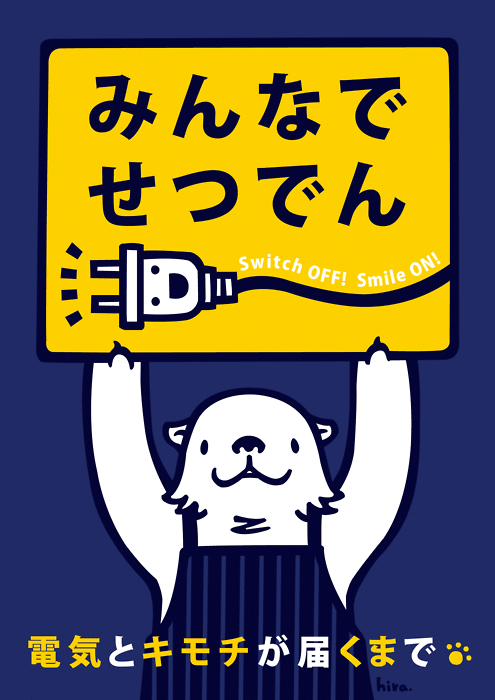
Everyone save electricity
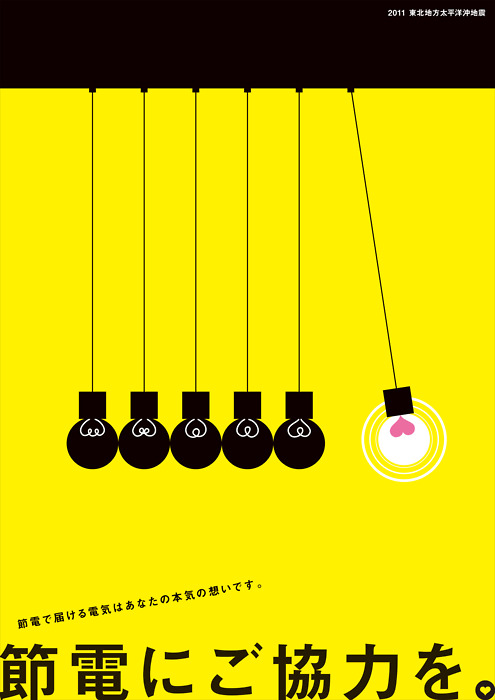
Please cooperate in conserving electricity
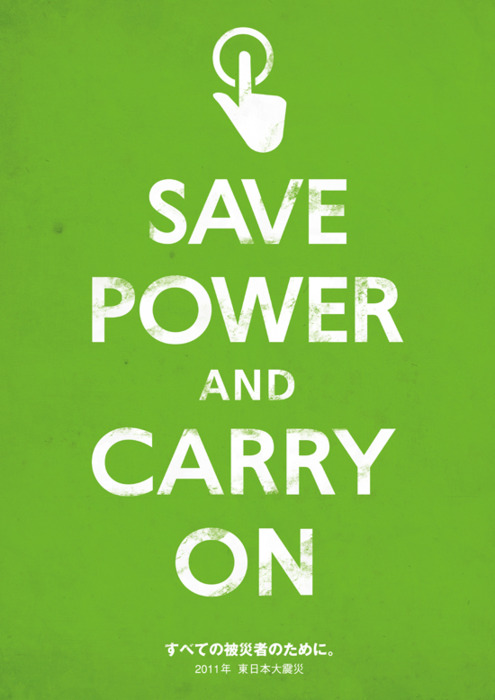
Save power and carry on
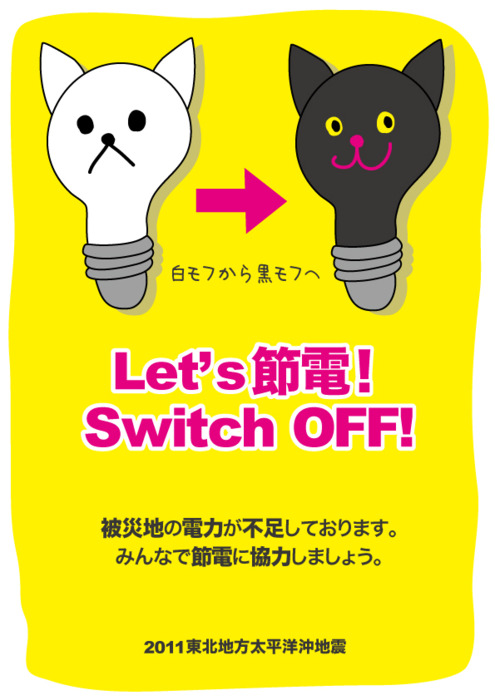
Let's conserve electricity! Switch OFF!

Turn OFF the power. Now anybody can be Santa.
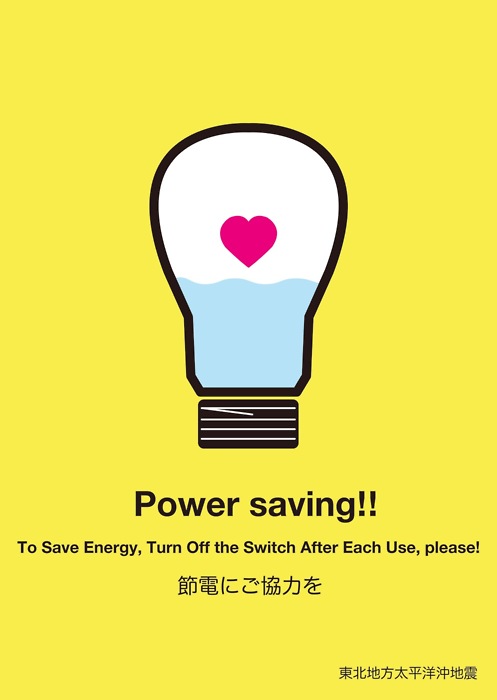
Power saving!
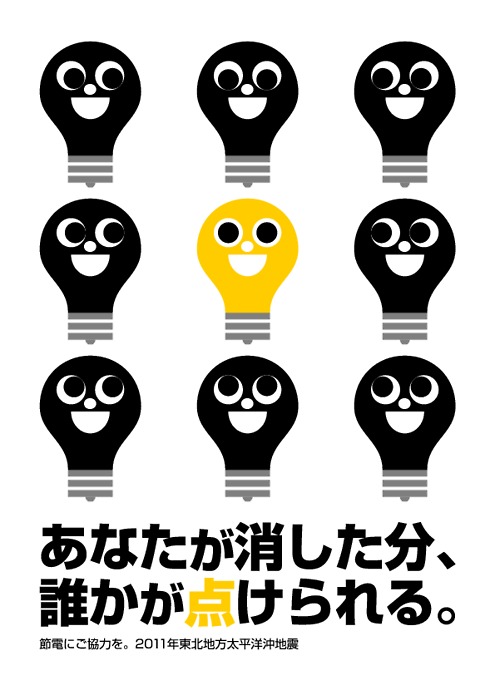
The amount you turn off will light someone else up.
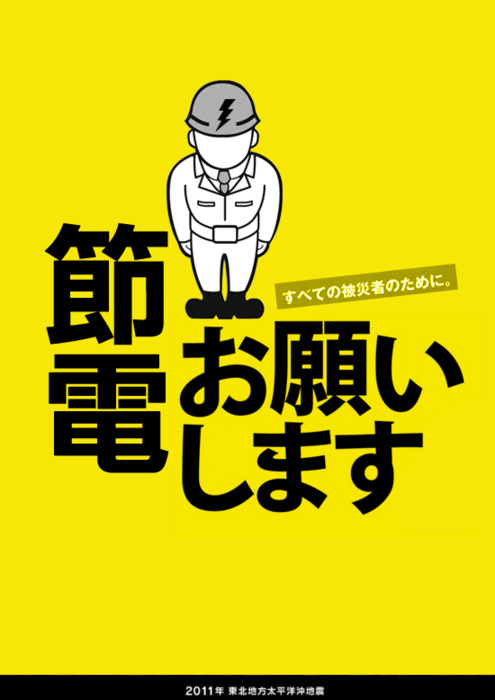
Please conserve electricity.
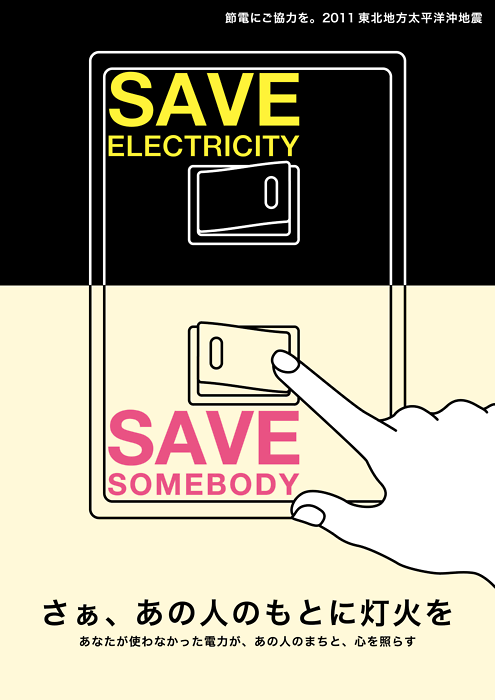
Save electricity. Save somebody.
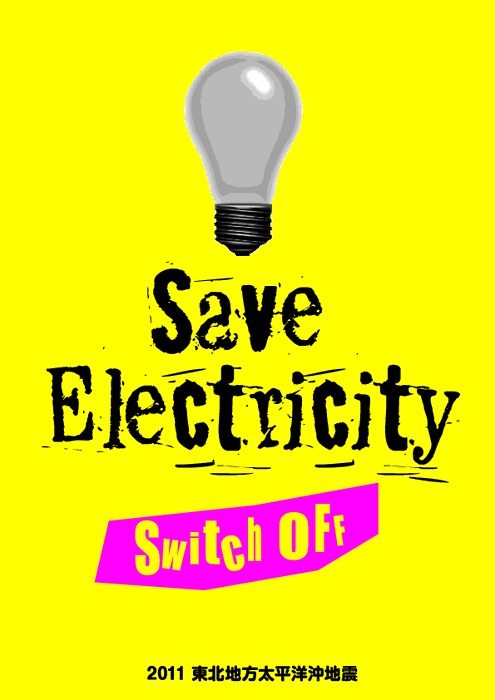
Save electricity. Switch off.
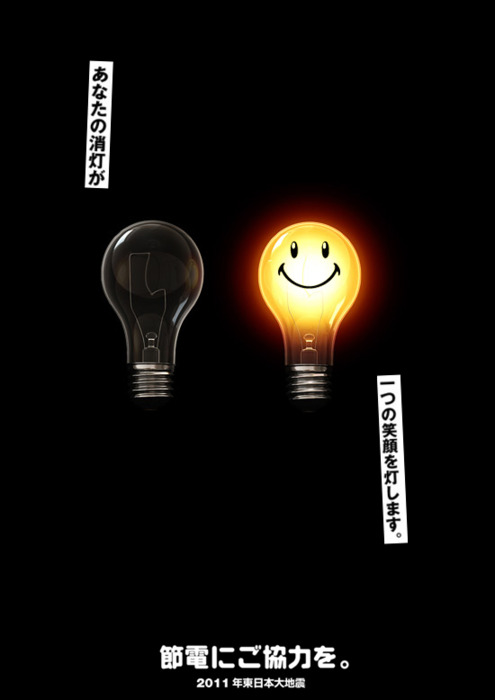
The light you turn off will light up a smile.
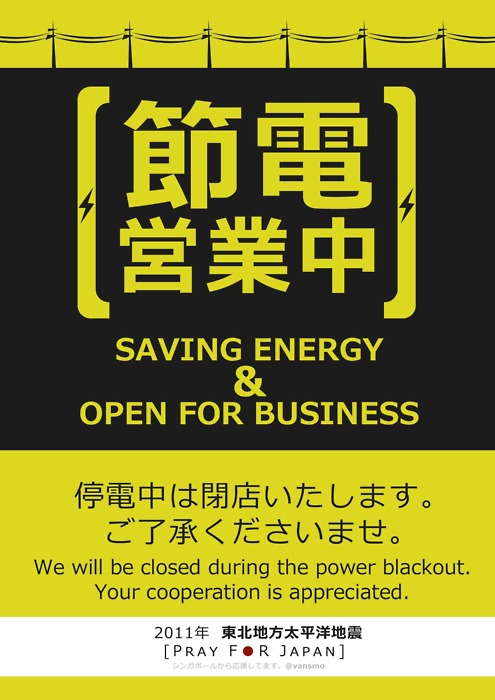
Saving energy & open for business
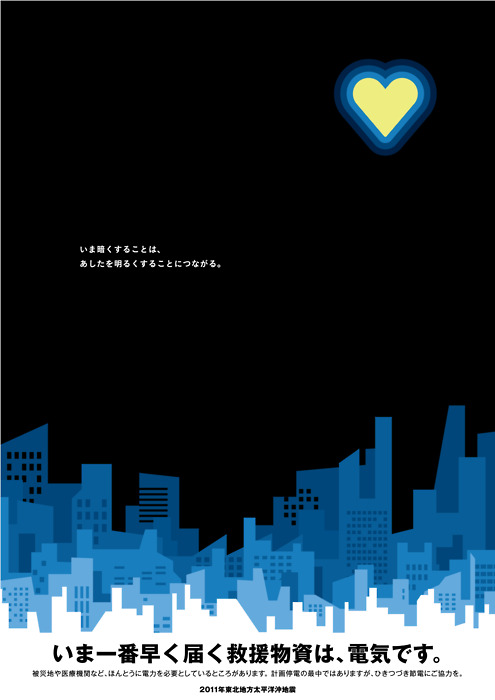
The quickest aid you can provide now is electricity.
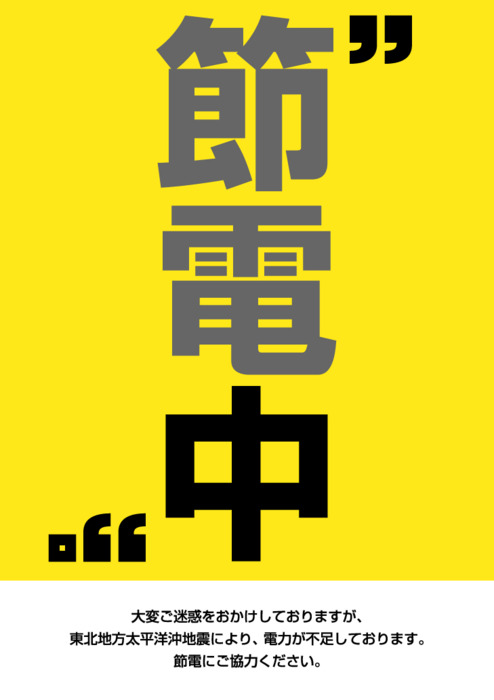
Now conserving power



Emergenza nucleare
Dall’inizio della crisi fino alla serata di ieri, 20 marzo, il valore della intensita' di dose gamma ("gamma dose rate – GDR”) e' stato consistentemente 0.04 microsievert/ora, cioe’ pari al fondo naturale di Tokyo. Come anticipato con precedenti comunicazioni, dalla tarda serata di ieri, domenica 20 marzo, e' stato riscontrato un aumento delle radiazioni che ha raggiunto nella notte il valore di 0.08 microsievert/ora. Alle ore 08:00 del mattino di oggi, anche grazie alla pioggia, il valore e' poi sceso ancora a 0.04 microsievert/ora.
I livelli di Iodio-131 e Cesio-137 misurati dai tecnici presenti in Ambasciata sono stati al di sotto del livello di rivelazione (assenza di tracce rilevabili) in tutto il periodo dal 16 marzo al 20 marzo sera. Nella notte tra il 20 ed il 21 marzo, in concomitanza con l'aumento della GDR, si e' tuttavia potuta evidenziare la presenza di questi due radioisotopi in valore numerico non quantificabile, essendo questo vicinissimo alla soglia minima di rivelazione.
Durante la missione di misurazione effettuata dagli esperti dei vigili del fuoco a nord di Tokyo, a Utsunomiya (Prefettura di Tochigi, circa 100 km a nord della capitale), il valore rilevato della GDR e' stato di 0.12 microsievert/ora (il valore comunicato dalle autorita' giapponesi per Utsunomiya e' di 0.15 microsievert/ora), con rivelazione radioisotopi artificiali di Iodio-131 e Cesio-137.
Come ribadito ripetutamente e confermato anche in questo caso, i valori direttamente registrati sia di GDR che per la presenza di radioisotopi escludono, al momento, la necessita' di adottare misure di protezione.
Alle 4:00 di questa mattina le squadre di intervento al sito nucleare di Fukushima-I hanno terminato le operazioni di immissione di acqua dall'esterno nella piscina di stoccaggio degli elementi di combustibile del reattore numero 3. La stessa operazione e' stata poi effettuata alla piscina del reattore numero 4. Misure di temperatura esterna dei reattori sono state effettuate utilizzando un sistema ad infrarossi montato su un elicottero. I valori riportati dalla JAIF sono stati: 58 Centigradi (reattore numero 1), 35C (numero 2), 62C (numero 3), 42C (numero 4), 24C e 25C rispettivamente per i reattori numero 5 e 6 gia' in fermo freddo ("cold shutdown"). Proseguono le operazioni di allaccio alla rete elettrica dei reattori e del conseguente ripristino dei vari sistemi di servizio per tutti i reattori.
Per quanto concerne il rischio sismico, secondo la Japan Meteorological Agency il livello di allerta ed i calcoli probabilistici per le scosse di assestamento dopo il grande terremoto dell'11 marzo rimangono invariati a quanto comunicato il 16 marzo.
Avviso ai connazionali
Anche se la situazione presso la centrale appare in via di progressivo miglioramento, l’emergenza non e’ ancora superata e non si possono pertanto escludere ulteriori, rilevanti danni ambientali con conseguenti rischi per la salute.
In tal senso, si ribadisce la raccomandazione ai connazionali di allontanarsi da Tokyo e dalle prefetture limitrofe, soprattutto a nord di Tokyo, e si scoraggiano quanti si fossero allontanati dalla Capitale a farvi, per ora, rientro.
L’Ambasciata ritiene che a ieri, domenica 20 marzo, a Tokyo fossero rimaste poche decine di connazionali ed invita quanti decidessero di rientrare malgrado il contrario avviso sopra ribadito, di avvertire dell’avvenuto rientro con apposita email all’indirizzo consular.tokyo@esteri.it avente per oggetto: “RIENTRO”. Chi rientrasse a Tokyo dovra’ predisporre autonomamente i mezzi per un’eventuale evacuazione in caso di improvviso deterioramento delle condizioni di contaminazione.
Trasporti Nella giornata di oggi operano regolarmente da Osaka tre voli Alitalia per Roma Fiumicino e Milano, con ampia disponibilita’ di posti.
AZ 793 AZ 793 per Roma Fiumicino delle ore 14.10 (arrivo alle ore 19.05)
AZ 787 per Malpensa delle ore 17.00 (arrivo alle ore 21.30)
AZ 785 per Fiumicino delle ore 19.30 (arrivo alle ore 00.15)
Il Governo italiano rinnova la disponibilità di posti gratuiti per i nuclei familiari e quanti si trovino in condizioni di vulnerabilità o stato di necessità.
Sarà accordata priorità alle famiglie con bambini minori di 15 anni e alle donne in stato di gravidanza.Il costo del trasferimento all’aeroporto di Osaka sarà a carico degli interessati.
Ulteriori scali in Italia saranno a carico del passeggero.
Gli interessati dovranno presentarsi direttamente al banco accettazione dell'Alitalia presso l'aeroporto di Osaka e iscriversi in lista d'attesa. Presso lo stesso banco accettazione, a partire dalle ore 11.00 e sino alla partenza dell'ultimo volo Alitalia, sarà presente un presidio di personale dell’Ambasciata e del Consolato Generale d'Italia in Osaka per assistere i connazionali in partenza.Il Consolato Generale d'Italia in Osaka, rafforzato con personale trasferito dall'Ambasciata d'Italia in Tokyo, continua a operare 24 ore su 24 e risponde ai recapiti telefonici 06 4706 5820 ed al cellulare di servizio 090 3350 1561 (attivo anche nelle ore notturne) e all'indirizzo e-mail consolare.osaka@esteri.it. L'Ambasciata d'Italia in Tokyo è aperta e raggiungibile H 24 al recapito consular.tokyo@esteri.it e, telefonicamente, al centralino (03 3453 5291) ed allo 03 3453 5274.
IAEA Briefing on Fukushima Nuclear Emergency (19 March 2011, 14:00 UTC)
On Saturday, 19 March 2011, Graham Andrew, Special Adviser to the IAEA Director General on Scientific and Technical Affairs, briefed both Member States and the media on the current status of nuclear safety in Japan. His opening remarks, which he delivered at 14:00 UTC at the IAEA headquarters in Vienna, are provided below:
1. Current Situation
The situation at the Fukushima Daiichi nuclear power plants is similar to that which I described yesterday.
Efforts to restore electrical power to the site continue. It is hoped that power will be restored to Unit 2 today, which will then act as a hub for restoring power to Unit 1. However, we do not know if the water pumps have been damaged and if they will work when power is restored.
Seawater is still being injected into the reactor pressure vessels of Units 1 and 2 and additional fire trucks have arrived, reinforcing the operation to spray water into the Unit 3 reactor building.
We still lack reliable validated data on water levels and temperatures at the spent fuel pools at Units 3 and 4.
Temperatures at the spent fuel pools in Units 5 and 6 have risen in the past few days but this does not give rise to immediate concern. Water continues to be circulated within the reactor pressure vessels and the spent fuel ponds at both units.
A second diesel generator is providing power for cooling at Units 5 and 6. We have been informed that holes have been made in the roof of the reactor building at Units 5 and 6 to avoid the risk of a hydrogen explosion.
2. Radiation Monitoring
Radiation levels in major Japanese cities have not changed significantly since yesterday.
The IAEA radiation monitoring team took measurements at seven different locations in Tokyo and in the Kanagawa and Chiba Prefectures. Dose rates were well below those which are dangerous to human health.
The monitoring team are now on their way to Aizu Wakamatsu City, which is 97 km west of the Fukushima nuclear power plant. They have just provided initial measurements from three additional locations.
Measurements made by Japan in a number of locations have shown the presence of radionuclides - ie isotopes such as Iodine-131 and Caesium-137 - on the ground.
This has implications for food and agriculture in affected areas. The IAEA and the UN Food and Agriculture Organization (FAO) are consulting with the Japanese authorities on measures being taken in these areas related to food and agriculture.
The Japanese Ministry of Health, Labour and Welfare has announced that radiation levels that exceeded legal limits had been detected in milk produced in the Fukushima area and in certain vegetables in Ibaraki. They have requested the Bureau of Sanitation at the Fukishima Prefectural Office, after conducting an investigation of the relevant information, to take necessary measures, such as identifying the provider of these samples and places where the same lots were distributed and banning sales based on the Food Hygiene Law. (Note: The text originally read out at the briefing was: "The Japanese Ministry of Health, Labour and Welfare informed the Agency that radiation levels exceeding legal limits had been detected in milk produced in the Fukushima area and in certain vegetables in Ibaraki. The Ministry ordered protective measures including a ban on sales of these products." An oral correction was made during the media briefing.)
We now have continuous online access to data from CTBTO radionuclide monitoring stations, which is being evaluated by Agency dosimetry specialists.
As far as the Fukushima Daini nuclear power plant is concerned, there is no record of any incidents or radiation releases at the site. Present elevated radiation levels at the Daini site are attributed by Japan to events at the Daiichi nuclear power plant.
3. Agency Activities
The Director General has left Tokyo for Vienna after meetings with senior government leaders and officials from the plant operator TEPCO.
As you know, he plans to brief the Board of Governors on Monday on the outcome of his trip.
15 March 2011
The Government's Chief Scientific Officer Professor John Beddington comments on the developments following the explosion at Fukushima nuclear plant.Following the explosion at Fukushima nuclear plant, the Japanese government has advised all people between 20 and 30kms of the plant to stay inside and keep windows closed. The 20km exclusion zone remains in place.
The UK Government advises all British citizens to follow this guidance.
The Chief Scientific Adviser said the Japanese Government’s advice is entirely proportionate and appropriate to the risk.
So I think I will pass over really to David Fitton I think we’re all here.
[DF] Thanks very much. Just to welcome everybody yet again. We’ve got a number of people dialling in individually and some groups as well dialling in. You’re all very welcome. I hope you can hear ok. I really just wanted to get a number of you together really just to talk about what we’ve been doing at the Embassy very quickly. A couple of minutes and then I want to hand over to Sir John. As you know we have been updating our travel advice and the links to it on our internet site here at the Embassy in the light of what’s happened following the earthquake on Friday, subsequent shocks, the tsunamis of course and importantly for this call, what’s been happening on the nuclear side. I know many of you here in Japan have been following this very closely on the Japanese TV and on the international news and I took part in a telephone meeting which Sir John briefed a number of us on about a day and a half ago. It was very useful to have his and his colleagues’ expert views.
Given the number of different rumours, stories and press articles which are circulating here in Japan I thought it might be useful for people to hear the views of an expert and his colleagues in London because those views are helping us when we put together our travel advice and the information on the internet. We update it regularly in the light of the facts which we know of here, and the expert guidance we get from our Japanese colleagues. But we also take fully into account the guidance received back in the UK on scientific, nuclear, geological and other issues. So that’s my very brief introduction Sir John. I would be very grateful if you could say a few words about your view of what’s happening in the light of what we’ve been reporting back to you and what you’ve fed in to the reports we’ve issued here. Is that ok?
[JB] Yes, of course. What I’m going to do is go into a bit of a stream of consciousness about how we see the situation and then I’ll talk about what would be a reasonable worst case, what we think is the most likely case, but also, you know,[unclear] all the time. The basic situation is, you know, is the Japanese are trying to keep the reactors cool by pumping sea water that will keep the temperature down; that’s their first line of defence. And up to now that’s been working… reasonably well. Basically the reactor lies within a large containment vessel. But if it isn’t cooled particularly well, then the pressure in the containment vessel goes up and it reaches a level where it can’t cope. At that stage the Japanese authorities deliberately release a mixture of steam and hydrogen gas and so on into the atmosphere. This is really quite modest amounts of radioactive material and it’s not likely, by and large, one shouldn’t be concerned about it.
It appears however that from this morning’s results that one of the containment vessels may be somewhat cracked. That’s new information that came through I think like 5 in the morning Japan time. The situation is still much the same. What they’re going to continue to try to do is keep the temperature low, keep the pressure within the containment vessels within those tolerance limits. That will involve very limited amounts of radioactive material going out. Now that’s what is I think is happening at the moment. Now the first thing to say about that is do we have any concerns now in terms of human health. Well the answer is yes we do, but only in the immediate vicinity of the reactors. So the 20 kilometre exclusion zone the Japanese have actually imposed is sensible and proportionate. If they extended out a little bit more to 30 kms, that is well within the sort of parameters that we would think are extremely safe.
Let me now talk about what would be a reasonable worst case scenario. If the Japanese fail to keep the reactors cool and fail to keep the pressure in the containment vessels at an appropriate level, you can get this, you know, the dramatic word “meltdown”. But what does that actually mean? What a meltdown involves is the basic reactor core melts, and as it melts, nuclear material will fall through to the floor of the container. There it will react with concrete and other materials … that is likely… remember this is the reasonable worst case, we don’t think anything worse is going to happen. In this reasonable worst case you get an explosion. You get some radioactive material going up to about 500 metres up into the air. Now, that’s really serious, but it’s serious again for the local area. It’s not serious for elsewhere even if you get a combination of that explosion it would only have nuclear material going in to the air up to about 500 metres. If you then couple that with the worst possible weather situation i.e. prevailing weather taking radioactive material in the direction of Greater Tokyo and you had maybe rainfall which would bring the radioactive material down do we have a problem? The answer is unequivocally no. Absolutely no issue. The problems are within 30 km of the reactor. And to give you a flavour for that, when Chernobyl had a massive fire at the graphite core, material was going up not just 500 metres but to 30,000 feet. It was lasting not for the odd hour or so but lasted months, and that was putting nuclear radioactive material up into the upper atmosphere for a very long period of time. But even in the case of Chernobyl, the exclusion zone that they had was about 30 kilometres. And in that exclusion zone, outside that, there is no evidence whatsoever to indicate people had problems from the radiation. The problems with Chernobyl were people were continuing to drink the water, continuing to eat vegetables and so on and that was where the problems came from. That’s not going to be the case here. So what I would really re-emphasise is that this is very problematic for the area and the immediate vicinity and one has to have concerns for the people working there. Beyond that 20 or 30 kilometres, it’s really not an issue for health.
[JB] OK well that’s kind of my spiel but I’ll pass to Hilary Walker now and Hilary will give you an overview of the health issues. Ok I’m going to pass to Hilary Walker now.
[HW] I just wanted to emphasise what we’ve just been talking is about outside the area it’s not a health problem. Those of you who are living in Tokyo, you are a long way away from the reactor, and although there have been reports that there have been slightly increased levels of radiation, this is trivial in terms of a health effect. So we would like to reassure people that well away from the reactor there is not an issue for people living around there
[JB] So David, that’s the view from here. We’re happy to answer any questions if people would like but the basic message is apart from that 20 kilometres or so around the reactor itself, there is really no human health issue that anyone need have concern about.
[DF] OK thank you very much Sir John. I’m just going to try and do this but we might run into problems with questions. If I may I’m going to start with the people sitting round the table with me because I can see them and I can control them. Perhaps I could ask if anybody round this table here first of all has got any questions they’d like to put to our colleagues in London. Yes there’s one behind me.
[Q] Yes, I’d just like to ask, there are reports as you say of higher than normal radiation levels in Tokyo. I think I saw one report of eight times normal. What kind of multiple of normal should we be worried about?
[JB] I’ll pass that to Hilary or to Lesley.
[HW] Well to begin with it would have to be many multiple times a background level to really be an issue. Orders of a hundred or so.
[JB] Yes, I agree.
Yes, ok so I don’t know whether that came through but basically eight times, don’t worry at all, eight times is really nothing. It’s the, it’s when it get to a hundred, two hundred, three hundred times that we really have to be concerned and the question if there is eight times in Tokyo tomorrow it’s normal, it’s nothing…
[DF] I think also Sir John, this is David Fitton again, there is a point too isn’t there in the distinction between times normal and times what is permissible is that the right word?
[JB] Absolutely, Hilary, what is seen as the permissible dose?
[HW] Much higher than what we’re seeing as background, you’re talking almost a hundred times that.
[JB] Yes.
Yes. Ok so permissible would be a hundred times the background.
[DF] OK thank you very much. I’ll move quickly on. We’ve got one more question in this room. Kevin?
[Q] Yes it was just to pick up on that previous question so Tokyo Metropolitan Government are publishing levels of radioactivity, extremely small in Tokyo as you rightly point out. I think the scale is micro gray and I don’t expect you to answer this now but it would be useful to get a sort of a figure on what would be acceptable. I’m very happy to send that link through to you but just to say that Tokyo Metropolitan Government is publishing those sorts of figures.
[JB] Ok, Hilary, question.
[HW] Right. It would be very helpful if those figures were sent through to us but if you’re talking of micro gray or micro something then you’re talking low levels.
Very low levels. No human health issue whatsoever.
[DF] Thank you very much. Can I move on to one more question please? David?
[JB] OK Sorry just to amplify, in terms of those sort of levels, we’d only be worried if it was thousands times that.
[DF] Thank you very much. David?
[Q] One confirmation, one question. Confirmation it sounds like from your assessment that it is coming on the basis of that your knowledge of this plant as opposed to information that’s coming from the Japanese Government. Concerns here are that information coming from either TEPCO or the Japanese government is not correct. Is my assumption correct, that you are basing what you know on the basis of your knowledge of this particular facility as opposed to any information you are getting from the Government? And the second part is, my own understanding is that the risks remain probably high for perhaps up to 10 days then they will begin to dissipate. But when can you anticipate that risks begin to dissipate?
[JB] OK in terms of the information we’re getting most of the information we’re getting is what the Japanese authorities have been putting into the appropriate international agencies. That’s the normal course of events. There may be merit if we can establish it in actually getting some direct information from them. But what they’re putting out is pretty comprehensive and it’s going into the appropriate international organisations. So the other point here is that in fact you know I want to sort of give some reassurance that you know even if you had a completely paranoid view that somehow the radiation was being concealed, you can’t do it, it’s monitored throughout the world. We know we can actually monitor exactly what the radiation levels are around there externally so it’s just not happening. You know, there is a degree of concern about whether the Japanese Government are actually giving all the information out , but in fact we are getting information through the international energy agencies and we do have pretty detailed knowledge of what these plants are like. And we’ve had input in from our health and safety executive colleagues who know these types of plants from the national nuclear laboratory and the Chief Exec of there has helped out with the SAGE group, has worked in Japan a few tens of kilometres from this particular site. So he knows those issues fairly well. So we’re pretty confident that’s what we’re getting.
The second question you asked was how soon can we relax? Straight answer to that is don’t know. I think you know there are so many uncertainties. I was slightly surprised that there was an explosion this morning. I thought that what happened was that a valve that was actually providing sea water for cooling, broke and jammed, and therefore the sea water cooling wasn’t operating in an efficient way. I presume they’ll be fixing that. The key is to get water in, get keep the whole thing cool, keep it within a reasonable pressure and we should be ok. I was asked on the Today Programme this morning in London about the same question and I said you know in around 10 days we may be able to be feeling that nothing much worse... but that is a big if and I really would not want to say anything at this stage in detail.
[DF] Thanks very much, I’ll move on to another question here.
[Q] There are obviously a lot of people in great need in the North East of Japan at the moment. What recommendations would you give to anybody who was going up there to do volunteer work?
[JB] Hilary, will you take that?
[HW] Well the Japanese national authorities are very experienced and have well developed plans and the key thing to do is to actually obey the national authority. If they ask you to move away, move away, if they ask you to shelter, shelter.
[DF] Thank you and I suppose part of the answer to that at the moment is the 20 now 30 in some areas zone is one that should be respected.
[JB] Absolutely. Anyone, don’t even dream of going into those areas. I don’t suppose for a moment the authorities would let you in but don’t even dream of trying. That would not be a good plan. In the immediate vicinity there is definitely a problem for people, but by and large as I understand it, almost everybody has been moved out of that 20 kilometre zone so hopefully all will be well.
[DF] Thank you, sir. Another question if I may?
[Q] You’ve said that at Chernobyl radioactive material went up to 30,000 feet, but you’ve also said that the worst case scenario here is for it to go up to 500 metres. Could you just explain why the worst case scenario here is much less than at Chernobyl?
[JB] Yeah, very much so. In Chernobyl, , first of all the top blew off the reactor and then the core of the reactor, the graphite which surrounds the core actually caught fire and burned for a very long time, so you had very, very, hot fire pushing all the material up in the normal sort of convection processes. Here, what will happen with the build up of pressure if the radioactive material interacted with the container floor and you would get a single explosion but it would not be a continued explosion. So that explosion would send material up to about 500 metres would be the sort of level we would expect. You know, it’s spurious accuracy, it might be 517 or 483 but that’s about it. And in terms of that, and couple that with weather, we still see absolutely no issue of material being taken at any critical level for human health beyond that 20 kilometres or so.
[DF] Thank you very much. I think we’ve got one more question in this room.
[Q] Good morning. Couple of days ago the Japanese authorities predicted a 70% chance of another aftershock exceeding magnitude 7, and potentially another tsunami. If that were to happen and the emergency procedures that are taking place now, how does that affect your worst case scenario?
[JB] I think the worst case scenario would remain. The issue is basically that if they can’t, if for example, their attempt to cool fails, and if their attempts to keep the pressure in the containment vessel fails, then you would get an explosion. What I suppose, you know, in a reasonable worst case that that would happen in a single reactor, if you had a massive new influx of tsunami and so on, you move into a sort of relatively low probability event, but you might get more than one, but the point still remains that you would actually have no real concerns even if there were two rather than one explosions, they don’t multiply it up, it doesn’t mean that it goes up to 1,000 metres or anything like that. It’s still up to about 500 metres, it still is a relatively short duration and the key thing here also is wind direction. When does it happen? If the wind is taking material, is going out into the Pacific, it is not going to be a problem. It’s the combination, as it were, unhelpful weather, and an explosion that is twice that reasonable worst case scenario. If you had this sort of second tsunami so that people could not work and actually operate on the core then you would have a problem. But that would probably mean that you might get all three reactors go up. But again, I’d emphasise this would not affect the advice we are giving.
[DF] OK thank you I’ve got one last question from this room. And if we’ve got time I’d like to allow the other rooms and other individuals.
[Q] At the moment the British School is closed and it is a highly sensitive situation as you can appreciate for parents and children as well as staff. It seems to me that your recommendation is that reasonable action by me is that I should reopen our school within 10 days or so. Is that correct?
[JB] In terms of opening the school there’s absolutely no need to close the school in terms of anything to do with concerns about radioactive material so that… but I presume its being closed due to other factors. Certainly there would be no necessity to close the school on the basis of any form of radiation coming down into the area. But Hilary do you want to expand on that?
[HW] No, I presume your school is in Tokyo? There’s no reason at the moment to do anything else but normal activities in the Tokyo region.
[DF] Thanks very much. I should say myself speaking here again, the school is partly closed for other reasons. Power cuts and traffic disruption, so, but that’s useful. I’m going to ask there are some people in the learning and development room in the other building. Are there any questions from there but try only to ask one at a time please?
[Q] We’ve got about 30 staff and families here and I’ve collated the questions they have. We’ve got about four questions. First of all, a question about Chernobyl. It was after Chernobyl, some people in other countries got sick. Why was that if the event would have been contained?
[JB] OK Hilary.
[HW] The difference here is that we are talking about after Chernobyl there were lots of people in other countries who landed up eating contaminated food and drinking contaminated water. We believe the situation will be very different in Japan where they have extremely well developed plans, and they would be able to ensure that you could not drink contaminated water or eat contaminated food. They did not suffer from the direct effects of radiation from the accident itself.
[DF] Next one.
[Q] The next one is about levels of radioactivity for children and pregnant mothers. Is there a different level that is acceptable?
[JB] Hilary.
[HW] Thank you, thank you Sir John. The levels of acceptability are based on the most sensitive groups, so they are taken into account when we look at the levels of radiation that is deemed acceptable.
[JB] OK so when we’re saying look you know it would have to be a hundred or a thousand times worse, that is for children and pregnant women, not for, you know average fat people like me.
[Laughter]
[Q] The next question, there’s a lot of concern in the community about the taking of iodine. At what point should iodine be taken and would you recommend people taking it proactively?
[JB] I think I know the answer to this, but I’m going to let Hilary or Lesley answer.
[HW] Actually the person I think would be answer that is, our HPA physician who knows a lot about these things, Nick Kent, are you on?
[NK] Yes, I am. I think I’ll answer it in two ways. The ways you may get exposed to radio iodine are either you inhale volatile radio iodine and that will only happen very close to the nuclear power plant itself, and we certainly do recommend where people are close to a nuclear plant when an accident occurs that they should take stable iodine to block iodine uptake to the thyroid in those circumstances. But there’s nobody close to the nuclear plant and that’s not a means by which there will be exposure here, and therefore that’s not, you know that is not a reason to take iodine in the case of yourselves living in Tokyo.
The second but most important way that people get exposed to radio iodine is that as the radio iodine settles into the environment, it gets incorporated into crops, it gets taken up into animals and it gets excreted into milk. And the problem in the case of Chernobyl which is where quite a number of cases of thyroid cancer were seen, it is now clear that the exposure pathway in the Russian Federation and Ukraine was ingestion of contaminated food, particularly milk. Now, we do not envisage the food chain as being an issue for you to take it up, and in any case, to use iodine to protect against the food chain would take long term administration of iodine, which would not be appropriate for other reasons, like the effects that would be on the thyroid. So I’ll just summarise. You’re not close to the plant so you’re not at an inhalation risk which is the principle use for iodine, and you we do not envisage you getting any radio iodine exposure through the food chain so again you know, no exposure therefore no need to use iodine as a countermeasure. Thank you.
[DF] Thanks very much.
[Q] Yes, one more question. Under the reasonable case scenario you’ve outlined, what sort of strength of wind would it take actually to carry radioactive material from Fukushima to Tokyo for instance? Is it just there is no strength of wind possible to do it? Or it is, are you assuming some kind of wind strength in your reasonable scenario?
[JB] No, no. The….. basically, it just won’t happen.
[DF] OK if that’s all from there I wonder if I could ask the other group of people in the operations room - the old visa waiting room upstairs. Are there any questions from there? [Pause] Doesn’t sound like it.
This is going to be slightly more difficult. Any individual questions from individuals?
{Q} David, sorry can I just bust in, we’ve got one more question. Contact with people who have been contaminated.
[JB] Hilary. Or Lesley.
[HW] Well I guess the issue with contamination will be specific to people who were working on site, and obviously there’ll be decontamination procedures in place for those people. Outside the 30 kilometre zone we wouldn’t expect contamination to be an issue to cause public health concerns.
[JB] OK and I think that’s the point, you know, it’s, the people who are going to get the biggest dose are the people who are actually working on the reactor trying to solve the emergency problem. They will, they will be completely screened by the Japanese authorities; they will be decontaminated in a whole series of mechanisms which are well understood by the nuclear industry. The people in the 20 kilometre zone are highly unlikely I reckon by now to actually have got any serious level of radioactivity. If they, actually the authorities, pick it up I would be very surprised if they do, they will actually do the decontamination. Basically these guys are not going to leave the plant and walk into their neighbourhood bar, they will be actually undergoing very severe very significant decontamination.
[Q] Yes.
[DF] Yes, please go ahead.
[Q] This has been very, very, reassuring. Could a transcript or a podcast of this conversation go somewhere online so it reassures people?
[JB] Yeah, from our end we’d have no concerns about it.
[DF] I can answer that from the Embassy in Tokyo. That’s our plan. If we can physically get a podcast up we will or if not we’ll put a transcript up.
[Q] That is lovely, thank you very much.
[DF] Any more questions? Even if you’ve asked one before, I don’t mind.
[Q] Thank you. What about rainfall in Tokyo. You know, is it recommended to sort of stay indoors or, you know, wear a hat or anything like that? Thank you.
[JB] Not at all. The whole issue is because the height of this thing is going to go, you know, 500 metres, even if it explodes and it is nothing like that now, we’ve got no explosion, we’ve got no criticality, we’ve got no breakdown, but even in the reasonable worst case you’re going to have no issue, if there’s rain it’s going to be actually within that 20, 30 kilometre zone that you would get nuclear material deposited.
[DF] OK thank you. One more question next door.
[Q] Good. A follow up to the question I asked about people going up to do volunteer relief work. Is it correct to say that if they are like 50, 60 kilometres from Fukushima they are in no danger from radiation?
[JB] I think that’s the case. You should be aware that Hilary and Lesley my two health colleagues are both nodding at my comment.
[JS] John Simpson from HPA here. We’ve been giving advice on people going down to volunteer who are obviously outside the zone and the real risk to them is physical injury because of the disruptive nature, that’s the number one risk. The radiation would be way down the list of risks to them.
[DF] Thanks very much John, I’ve got a question.
[Q] Just one quick question. You mentioned about contamination of food, I just wondered if there’s any risk of contamination of sea-food?
[JB] Lesley.
[LP] There is a possibility of that, yes. But the Japanese have very good monitoring programmes in place and they would understand it to be a potential exposure pathway and then sure, before they allowed people to consume seafood, they would provide advice and undertake monitoring.
[DF] Thanks. One more question, I think we’ve got time if anybody would like to ask.
[Q] From the family room, there’s some explanation they’d like on what is a reasonable case scenario and what would be an unreasonable case scenario?
[JB] Well I think the, I can answer that to the extent we think the reasonable worst case would be one of the reactors going critical and exploding. I think the less likely is all three but it’s not impossible of course, but that would mean that in fact that the cooling procedures of pumping seawater had failed on all three, that the containment of the pressure in the containment vessels failed on all three, it just you know, to say there’s a chance of one, the chances of all three going is a multiple of that so it’s significantly less likely.
[DF] Ok I’m really very grateful. I’d like to wrap it up now I think. Sir John and colleagues in London I think we’ve really valued your very frank responses. I hope people will take time when we do get this up on the web and bear with us, it might take a little time, to look at it again. But thank you all very much indeed and, thanks for joining us today.
[JB] David just one more point is to say that you know, I would say that given the devastation that you’ve got in Japan and the hard work at the Embassy people are having to put in, I would characterise the nuclear issue as a sideshow. You’ve got a massive problem.
[DF] Thanks very much for that. Thank you very much again everybody.